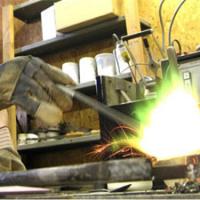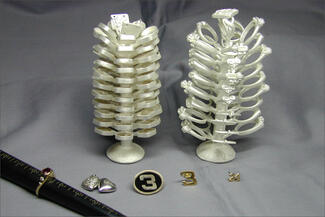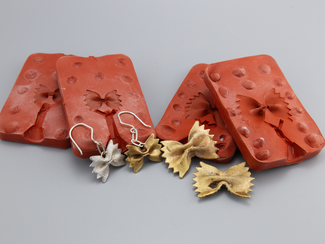Mold Making and Casting!
This three-day workshop is designed to demystify the process of mold making and casting using the lost-wax casting process. Students will gain a firm understanding of best practices in mold making and casting so they can be be cost effective in a when making multiples for a production environment.
Over the course of three days, Dan will take students step-by-step through the entire mold-making and casting process. On the first day, students will have the opportunity to make one to two molds during class using pre-made models, objects, or trinkets. On the second day, students will learn to sprue and invest their new molded wax pieces which will be cast on the third and final day of the workshop, in bronze. Students are welcome to purchase sterling silver casting grain themselves and bring at least a troy ounce or two to the class (link below in the Materials section).
Additional topics that will be covered in this workshop include how to properly cut open and vent molds in order to produce wax models, remove the sprues after casting, simple and quick finishing techniques, as well as an ongoing discussion of how to save time by designing wax models to incorporate findings, such as jump rings, ear posts, hinges, and catch location. Students will go home with molds and castings, as well as a better understanding of how to utilize these techniques for jewelry making and small sculptures.
Students should bring pieces that they have made in metal for vulcanized molding purposes, such as small pendants, rings and charms. Larger items like belt buckles can be discussed but may not fit in the frames and flasks available.
A special thanks to Contenti for helping to make this workshop possible.
Please be advised: we typically close registration for our onsite workshops the Tuesday of the week before the class start-date.
Meet the instructor

Daniel Grandi's jewelry-making experience began in Thailand in the late 1960's as a 13-year old apprentice in his parents' jewelry company, which made high quality 18 and 22K custom gold jewelry. Daniel worked alongside older goldsmiths working with traditional tools and methods; out of necessity, they made many of their own tools. Eventually, it was decided that the company would have to start casting their pieces in order to meet the demand.
Working with the company's caster, Daniel learned casting, model making, and how to hand-cut molds. The complexity of Thai jewelry design in the 1960's and 70's required the development of special techniques in order to create products that retained the look and feel of hand made jewelry, but which could be easily reproduced.
In 1980 Daniel moved to the US and worked as a jewelry machine designer. He also worked and developed vulcanized silicone rubber for Lost-Wax Industries. As a jewelry machine designer for Lostwax, he also worked in sales and had the opportunity to visit large jewelry manufacturers all over the U.S. and abroad; he was recognized for his experience in high-volume manufacturing and was consulted when problems were encountered. Today he puts his nearly four decades of experience to work at RaceCar Jewelry Co., a full-service investment casting and finishing shop in Pawtucket, Rhode Island, which can produce raw and finished products in all metals, he says, but "unobtanium.".
Materials & Tools
There is a $35 materials fee for this workshop which is payable upon registration. The materials kit includes bronze casting grain; mold rubber for molds; investment for casting; injection wax for models; sprue-former; and other miscellaneous consumable items needed to complete the workshop objectives.
Students are welcome to purchase sterling silver casting grain themselves and bring one or two troy ounces to the class. Please note that you will likely have left over casting grain.
- Closed-toe shoes - required in the Metalwerx studio
- Small metal pieces to be molded (jewelry--small pendants, rings, and charms; as well as small-scale sculptural objects--no larger than an inch or so tall and wide.)
- Wax models, plastics, or any other pieces you have questions about may be permitted on a discussion basis
- Notebook/pen for taking notes and for sketching
- Studio apron or studio clothing
- Studio towel
- Lunch - Metalwerx has a fridge, toaster oven, and microwave


